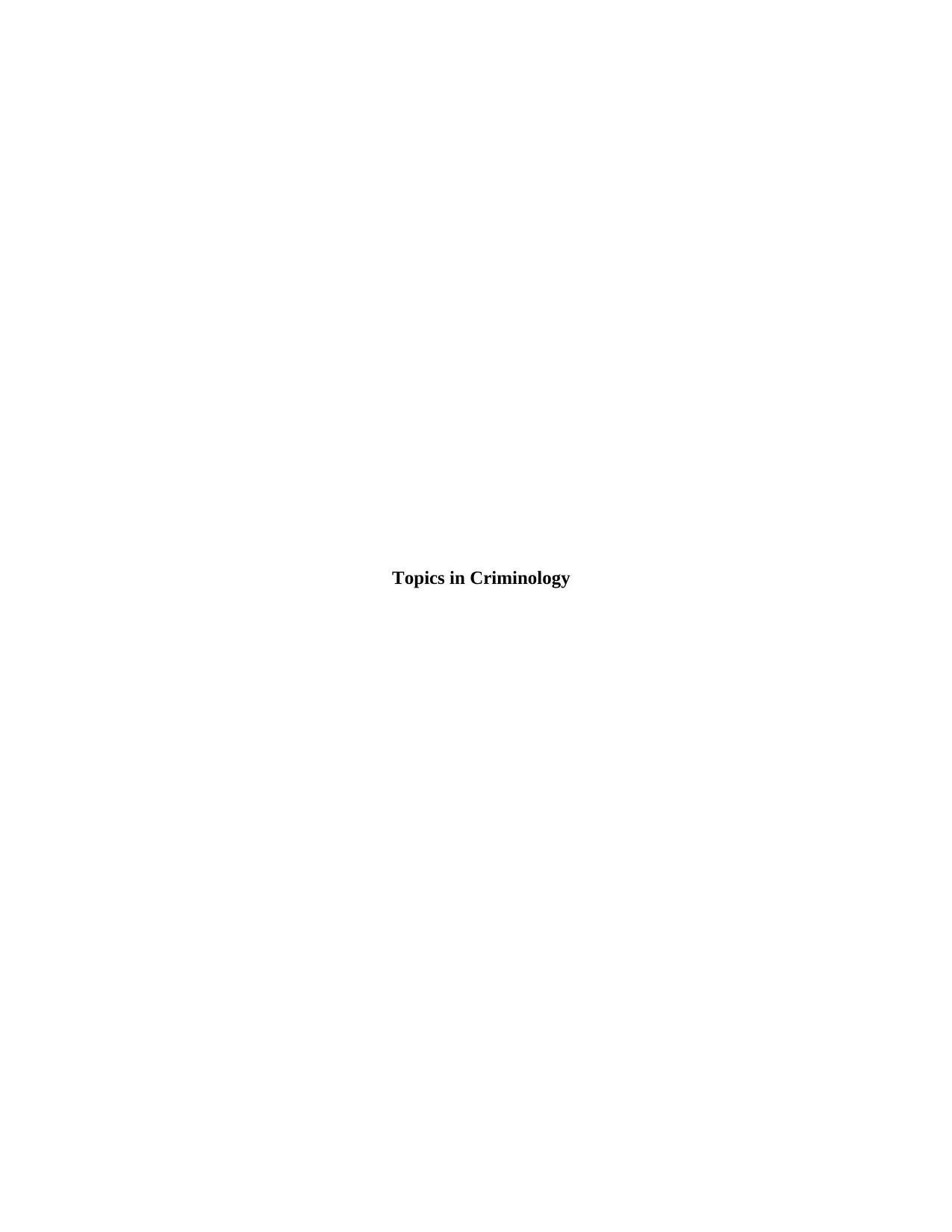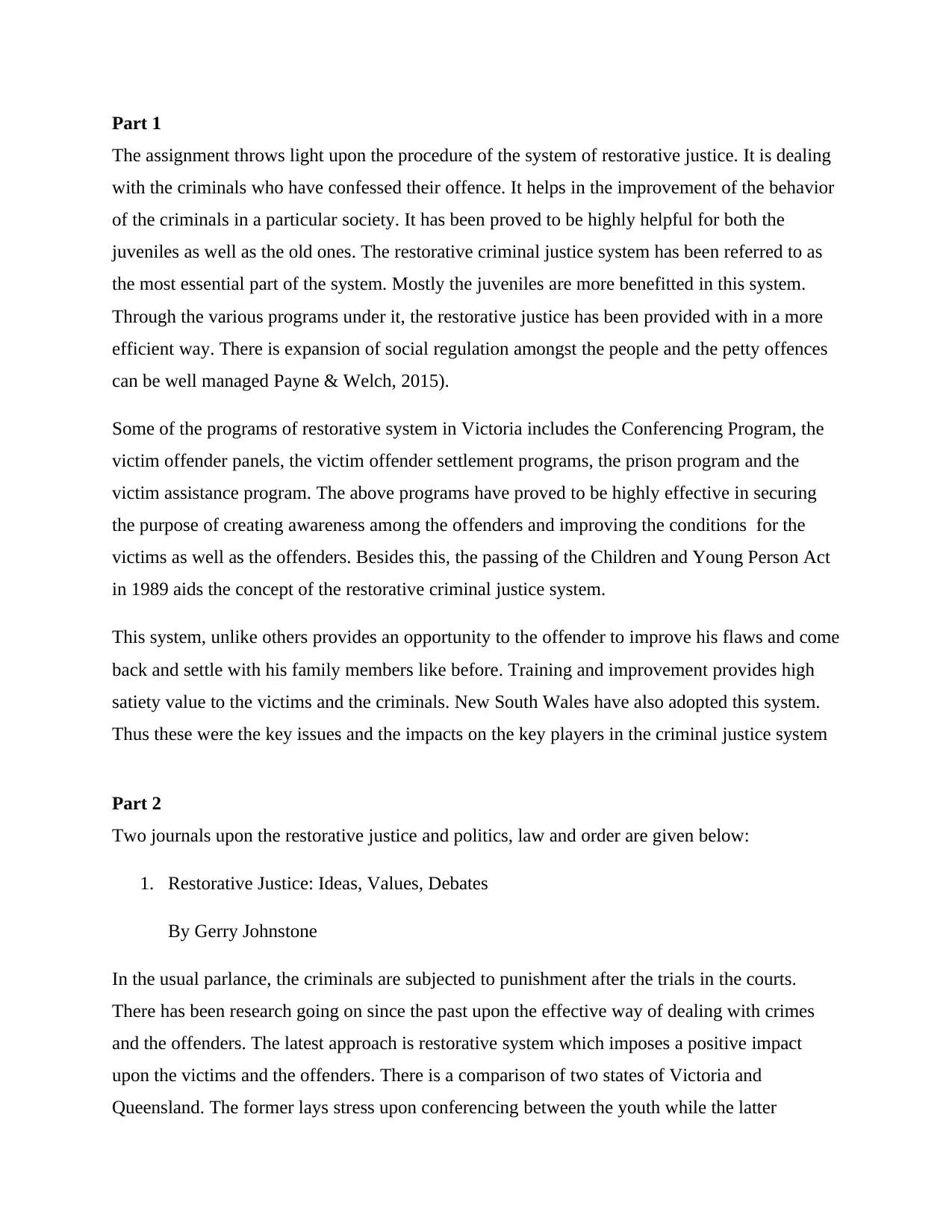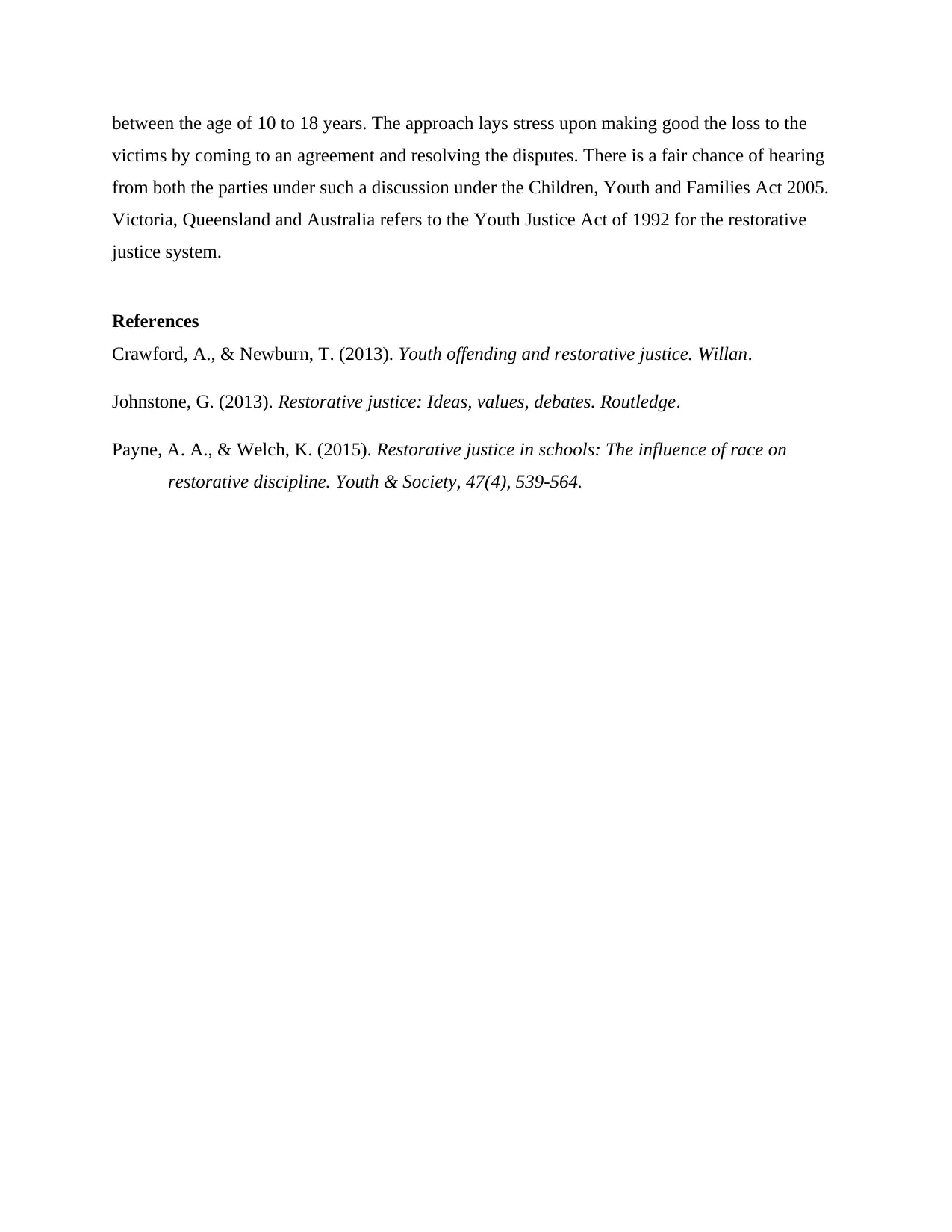Restorative Justice: Key Issues and Impacts on Criminal Justice System
VerifiedAdded on 2023/04/21
|4
|944
|366
Report
AI Summary
This assignment delves into the restorative justice system, highlighting its procedures and benefits for both juvenile and adult offenders. It emphasizes the system's role in improving offender behavior and supporting victims through various programs like conferencing, victim-offender panels, and prison programs in Victoria and New South Wales. The analysis includes annotated feedback on two sample assignments, focusing on restorative justice, politics, law, order, and media representations. The report concludes that restorative justice offers an effective approach to criminal justice by prioritizing victim compensation and offender rehabilitation through agreements and dispute resolution, referencing key legislative acts and scholarly articles to support its findings.

Topics in Criminology
Paraphrase This Document
Need a fresh take? Get an instant paraphrase of this document with our AI Paraphraser

Part 1
The assignment throws light upon the procedure of the system of restorative justice. It is dealing
with the criminals who have confessed their offence. It helps in the improvement of the behavior
of the criminals in a particular society. It has been proved to be highly helpful for both the
juveniles as well as the old ones. The restorative criminal justice system has been referred to as
the most essential part of the system. Mostly the juveniles are more benefitted in this system.
Through the various programs under it, the restorative justice has been provided with in a more
efficient way. There is expansion of social regulation amongst the people and the petty offences
can be well managed Payne & Welch, 2015).
Some of the programs of restorative system in Victoria includes the Conferencing Program, the
victim offender panels, the victim offender settlement programs, the prison program and the
victim assistance program. The above programs have proved to be highly effective in securing
the purpose of creating awareness among the offenders and improving the conditions for the
victims as well as the offenders. Besides this, the passing of the Children and Young Person Act
in 1989 aids the concept of the restorative criminal justice system.
This system, unlike others provides an opportunity to the offender to improve his flaws and come
back and settle with his family members like before. Training and improvement provides high
satiety value to the victims and the criminals. New South Wales have also adopted this system.
Thus these were the key issues and the impacts on the key players in the criminal justice system
Part 2
Two journals upon the restorative justice and politics, law and order are given below:
1. Restorative Justice: Ideas, Values, Debates
By Gerry Johnstone
In the usual parlance, the criminals are subjected to punishment after the trials in the courts.
There has been research going on since the past upon the effective way of dealing with crimes
and the offenders. The latest approach is restorative system which imposes a positive impact
upon the victims and the offenders. There is a comparison of two states of Victoria and
Queensland. The former lays stress upon conferencing between the youth while the latter
The assignment throws light upon the procedure of the system of restorative justice. It is dealing
with the criminals who have confessed their offence. It helps in the improvement of the behavior
of the criminals in a particular society. It has been proved to be highly helpful for both the
juveniles as well as the old ones. The restorative criminal justice system has been referred to as
the most essential part of the system. Mostly the juveniles are more benefitted in this system.
Through the various programs under it, the restorative justice has been provided with in a more
efficient way. There is expansion of social regulation amongst the people and the petty offences
can be well managed Payne & Welch, 2015).
Some of the programs of restorative system in Victoria includes the Conferencing Program, the
victim offender panels, the victim offender settlement programs, the prison program and the
victim assistance program. The above programs have proved to be highly effective in securing
the purpose of creating awareness among the offenders and improving the conditions for the
victims as well as the offenders. Besides this, the passing of the Children and Young Person Act
in 1989 aids the concept of the restorative criminal justice system.
This system, unlike others provides an opportunity to the offender to improve his flaws and come
back and settle with his family members like before. Training and improvement provides high
satiety value to the victims and the criminals. New South Wales have also adopted this system.
Thus these were the key issues and the impacts on the key players in the criminal justice system
Part 2
Two journals upon the restorative justice and politics, law and order are given below:
1. Restorative Justice: Ideas, Values, Debates
By Gerry Johnstone
In the usual parlance, the criminals are subjected to punishment after the trials in the courts.
There has been research going on since the past upon the effective way of dealing with crimes
and the offenders. The latest approach is restorative system which imposes a positive impact
upon the victims and the offenders. There is a comparison of two states of Victoria and
Queensland. The former lays stress upon conferencing between the youth while the latter

emphasizes upon victim offender mediation. They are trained, improved and made aware of the
crimes they have committed. the requirements of the victims are fulfilled so that they do not
suffer any more.
Australia has adopted the various modes of restorative justice. It aims at the improvement of the
young offenders through conferences and post conference programs. These conferences are
conducted by the police, courts of the juvenile justice system (Johnstone, 2013).
2. Youth Offending and Restorative Justice
By Adam Crawford and Tim Newburn
The youth justice mechanism in Victoria and Queensland have undergone various changes. The
ingredients of the Restorative justice system have been introduced in this journal as per the
provisions of the restorative ingredients in the Youth justice and Criminal Evidence Act of 1999.
This system targets to put value upon the grievances and to heal the damages caused to the
victims by the offenders. There is excluding of capital and punitive punishments to the offenders.
This system helps in the reduction of recidivism. Regular revision of such programs have to be
undertaken for its smooth functioning (Crawford & Newburn, 2013).
Part 3
After a close perusal of the above information it can be concluded that the system of restorative
criminal justice is the latest approach of dealing with criminals in the most efficient manner.
When a crime has been committed against a person he wants to apply the retributive theory and
take vengeance. This theory advocates Hirschi’s Social contract theory over Recidivism. The
victims should be compensated for the loss suffered and their demands should be fulfilled. This
is the ultimate motive of securing justice under the criminal system. Hence, the restorative
approach has a different way of dealing with the offenders. Under this system, the people who
have a part in any crime, cannot cause harm to the people. They can together identify and refer to
the obligations and damages which has been caused to them.
There has been various units created for the criminal justice under this restorative approach.
Meetings are conducted between the criminals and the offenders who are mainly juveniles
crimes they have committed. the requirements of the victims are fulfilled so that they do not
suffer any more.
Australia has adopted the various modes of restorative justice. It aims at the improvement of the
young offenders through conferences and post conference programs. These conferences are
conducted by the police, courts of the juvenile justice system (Johnstone, 2013).
2. Youth Offending and Restorative Justice
By Adam Crawford and Tim Newburn
The youth justice mechanism in Victoria and Queensland have undergone various changes. The
ingredients of the Restorative justice system have been introduced in this journal as per the
provisions of the restorative ingredients in the Youth justice and Criminal Evidence Act of 1999.
This system targets to put value upon the grievances and to heal the damages caused to the
victims by the offenders. There is excluding of capital and punitive punishments to the offenders.
This system helps in the reduction of recidivism. Regular revision of such programs have to be
undertaken for its smooth functioning (Crawford & Newburn, 2013).
Part 3
After a close perusal of the above information it can be concluded that the system of restorative
criminal justice is the latest approach of dealing with criminals in the most efficient manner.
When a crime has been committed against a person he wants to apply the retributive theory and
take vengeance. This theory advocates Hirschi’s Social contract theory over Recidivism. The
victims should be compensated for the loss suffered and their demands should be fulfilled. This
is the ultimate motive of securing justice under the criminal system. Hence, the restorative
approach has a different way of dealing with the offenders. Under this system, the people who
have a part in any crime, cannot cause harm to the people. They can together identify and refer to
the obligations and damages which has been caused to them.
There has been various units created for the criminal justice under this restorative approach.
Meetings are conducted between the criminals and the offenders who are mainly juveniles
⊘ This is a preview!⊘
Do you want full access?
Subscribe today to unlock all pages.

Trusted by 1+ million students worldwide

between the age of 10 to 18 years. The approach lays stress upon making good the loss to the
victims by coming to an agreement and resolving the disputes. There is a fair chance of hearing
from both the parties under such a discussion under the Children, Youth and Families Act 2005.
Victoria, Queensland and Australia refers to the Youth Justice Act of 1992 for the restorative
justice system.
References
Crawford, A., & Newburn, T. (2013). Youth offending and restorative justice. Willan.
Johnstone, G. (2013). Restorative justice: Ideas, values, debates. Routledge.
Payne, A. A., & Welch, K. (2015). Restorative justice in schools: The influence of race on
restorative discipline. Youth & Society, 47(4), 539-564.
victims by coming to an agreement and resolving the disputes. There is a fair chance of hearing
from both the parties under such a discussion under the Children, Youth and Families Act 2005.
Victoria, Queensland and Australia refers to the Youth Justice Act of 1992 for the restorative
justice system.
References
Crawford, A., & Newburn, T. (2013). Youth offending and restorative justice. Willan.
Johnstone, G. (2013). Restorative justice: Ideas, values, debates. Routledge.
Payne, A. A., & Welch, K. (2015). Restorative justice in schools: The influence of race on
restorative discipline. Youth & Society, 47(4), 539-564.
1 out of 4
Related Documents
Your All-in-One AI-Powered Toolkit for Academic Success.
+13062052269
info@desklib.com
Available 24*7 on WhatsApp / Email
![[object Object]](/_next/static/media/star-bottom.7253800d.svg)
Unlock your academic potential
Copyright © 2020–2026 A2Z Services. All Rights Reserved. Developed and managed by ZUCOL.





